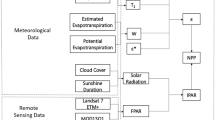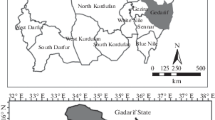Abstract
Primary productivity of ecosystem is important indicator about ecological assessment. Remote sensing technology has been used to monitor net primary productivity (NPP) of ecological system for several years. In this paper, the remotely sensed NPP simulation model of alpine vegetation in Qinghai Province of Tibet Plateau was set up based on the theory of light use efficiency. Firstly a new approach based on mixed pixels and Support Vector Machine (SVM) algorithm were used to correct simulated NPP values derived from Moderate Resolution Imaging Spectroradiometer (MODIS) data. Finally, spatial distribution and monthly variation characteristics of NPP in Qinghai Province in 2006 were analyzed in detail. The result showed that NPP of vegetation in Qinghai Province in 2006 ranged from 0 to 422 gC/m2/a and the average NPP was 151 gC/m2/a. NPP gradually increased from northwest to southeast. NPP of different vegetation types were obviously different. The average NPP of broad-leaved forest was the largest (314 gC/m2/a), and sparse shrub was the smallest (101 gC/m2/a). NPP in Qinghai Province significantly changed with seasonal variation. The accumulation of NPP was primarily in the period (from April to September) with better moist and heat conditions. In July, the average NPP of vegetation reached the maximum value (43 gC/m2). In our model, the advantage of traditional LUE models was adopted, and our study fully considered typical characteristics of alpine vegetation light use efficiency and environmental factors in the study area. Alpine vegetation is the most important ecological resource of Tibet Plateau, exactly monitoring its NPP value by remote sensing is an effective protection measure.
Similar content being viewed by others
References
Akihiko I (2008) The regional carbon budget of East Asia simulated with a terrestrial ecosystem model and validated using AsiaFlux data. Agricultural and Forest Meteorology 148(5): 738–747. DOI: 10.1016/j.agrformet.2007.12.007
Anita S, Chen J, Liu J (2004) Spatial scaling of net primary productivity using subpixel information. Remote Sensing of Environment 93(1–2): 246–258. DOI: 10.1016/j.rse.2004.07.008
Chen L, Gao Y, Li L (2007) Net primary production estimation of forest based on MODIS data. Chinese Science D: Earth Science 37(11): 1515–1521. (In Chinese)
David PT, William DR, Warren BC (2006) Evaluation of MODIS NPP and GPP products across multiple biomes. Remote Sensing of Environment 102(3–4): 282–292. DOI: 10.1016/j.rse.2006.02.017
Douglas EA, Stith TG, Mackay DS (2004) Heterogeneity of light use efficiency in a northern Wisconsin forest: implications for modeling net primary production with remote sensing. Remote Sensing of Environment 93(1–2): 168–178. DOI: 10.1016/j.rse.2004.07.003
Guo Z, Wang Z, Liu D (2009) Analysis of temporal and spatial features of farmland productivity in the Sanjiang plain. Transactions of the Chinese Society of Agricultural Engineering 25(1): 248–254. (In Chinese)
Gehrung J, Scholz Y (2009) The application of simulated NPP data in improving the assessment of the spatial distribution of biomass in Europe. Biomass and Bioenergy 33(4): 712–720. DOI: 10.1016/j.biombioe.2008.11.005
Xiao J, Zhuang Q, Beverly EL (2010) A continuous measure of gross primary production for the conterminous United States derived from MODIS and AmeriFlux data. Remote Sensing of Environment 114(3): 576–591. DOI: 10.1016/j.rse.2009.10.013
Huemmrich KF, Gamon JA, Tweedie CE (2010) Remote sensing of tundra gross ecosystem productivity and light use efficiency under varying temperature and moisture conditions. Remote Sensing of Environment 114(3): 481–489. DOI: 10.1016/j.rse.2009.10.003
Li G, Xin X, Wang D (2008) Estimation of grassland photosynthesis parameters based on MODIS-BASED-taking inner Mongolia as an example. Chinese Journal of Grassland 30(3): 1–7. (In Chinese)
Li Y, Zhao X, Cao G (2004) Analyses on climates and vegetation productivity background at Haibei Alpine Meadow ecosystem research station. Plateau Meteorology 23(4): 558–567. (In Chinese)
Lin X (2008) A simple introduction to LIBSVM. Available online: http://www.csie.ntu.edu.tw/~cjlin/libsvm (Accessed on 18 November, 2008)
Michael Z, Karl-Heinz E (2009) The global loss of net primary production resulting from human-induced soil degradation in drylands. Ecological Economics 69(2): 310–318. DOI: 10.1016/j.ecolecon.2009.06.014
Pontus O, Lars E (2007) Estimation of absorbed PAR across Scandinavia from satellite measurements. Part II: Modeling and evaluating the fractional absorption. Remote Sensing of Environment 110(2):240–251. DOI: 10.1016/j.rse.2007.02.020
Pu J, Li Y, Zhao L (2005) Seasonal changes of Kobresia Humilis Meadow biomass with climate factor. Acta Agrestia Sinica 13(3): 238–241. (In Chinese)
Shen Y, Xiang L (1991) The Physical Geography of Qianghai Province: 14–71, Ocean Press, Beijing. (In Chinese)
Tucker CJ, Townshend JRG, Goff TE (1985) African land-cover classification using satellite data, Science 227: 369–375. DOI: 10.1126/science.227.4685.369
Venturini V, Bisht G, Islam S (2004) Comparison of evaporative fractions estimated from AVHRR and MODIS sensors over South Florida. Remote Sensing of Environment 93(1–2): 77–86. DOI: 10.1016/j.rse.2004.06.020
Wang L, Wei Y, Niu Z (2008) Spatial and temporal variations of vegetation in Qinghai Province based on satellite data. Journal of Geographical Sciences 18(1): 73–84. DOI: 10.1007/s11442-008-0073-x
Yuan W, Liu S, Zhou G (2007) Deriving a light use efficiency model from eddy covariance flux data for predicting daily gross primary production across biomes. Agricultural and Forest Meteorology 143(3–4): 189–207. DOI: 10.1016/j.agrformet.2006.12.001
Yan H, Wang S, Wang C (2004) Impact of wind erosion on carbon cycle of fragile ecosystem in northern china. Quaternary Sciences 24(6): 672–677. (In Chinese)
Yu G, Sun X (2008) Flux measurement and research of terrestrial ecosystem in China. Science Press, Beijing. pp 597–632. (In Chinese)
Zhu W, Pan Y, He H (2006) Simulation of maximum light use efficiency for main vegetation in China. Chinese Science Bulletin 51(6): 700–706. (In Chinese)
Author information
Authors and Affiliations
Corresponding author
Rights and permissions
About this article
Cite this article
Wei, Yx., Wang, Lw. Simulating alpine vegetation net primary productivity by remote sensing in Qinghai Province, China. J. Mt. Sci. 11, 967–978 (2014). https://doi.org/10.1007/s11629-012-2615-z
Received:
Accepted:
Published:
Issue Date:
DOI: https://doi.org/10.1007/s11629-012-2615-z




